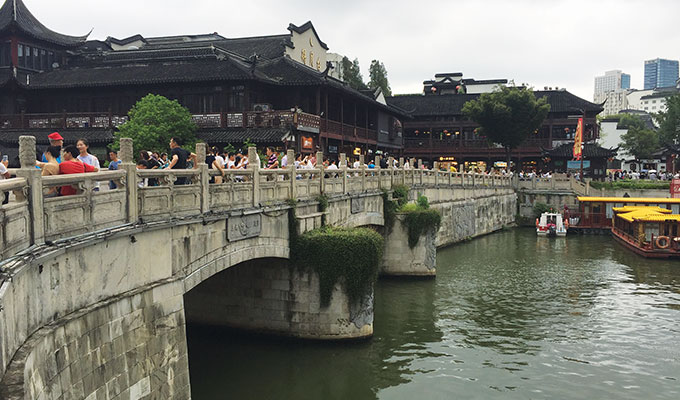There are just two National 5A Level Tourist Attractions in Nanjing, the somewhat obvious Dr. Sun Yat-Sen’s Mausoleum, and the Confucius Temple (Fuzimiao) area, in which lurks the less-than-usual suspect that is Wende Bridge. That may not in itself set bells ringing for many people, locals included, but when the Lantern Festival that marks the end of Chinese New Year is suggested, then most shall recall being one of the sardines making a pilgrimage to the bridge at this time of year on at least one occasion.
Yes this throng is indeed attracted by a celebration of the end of the festival, the visual spectacle of thousands of red lanterns with the temple’s backdrop of golden dragons and traditional pleasure boats, plus the camaraderie of the entire ensemble. Yet, while Wende Bridge is also the location from which many of those picture-perfect-postcard photos of Fuzimiao are taken, few are aware of the bridge’s place in the larger scheme of things, for therein a natural, astronomical phenomenon awaits, not withstanding the explaining thereof via a plaque by the bridge’s northern abutment.
Lying on a meridian, Wende Bridge draws a somewhat smaller crowd than that of the Lantern Festival, on the 15th day of the 11th lunar month each year. At midnight on this day, falling in 2018 on, coincidently, the Winter Solstice that is 21st December, the moon shall be directly over the bridge, leading to the celestial spectacle.
For at this time, those willing to stay up a little late and brave a cold winter’s night to trek over to Fuzimiao, shall be rewarded with a view of half the full moon while peering over at its reflection in the Qinhuai from one side of the Wende Bridge, and a similar view of the other half of the moon from the other side of the bridge. The astronomical occurrence may only happen on this particular day of the lunar year.
A floating bridge until 1585 CE, the bridge’s first permanent structure was a wooden-with-stone-piers design. It was to be repaired on many occasions, and survived until after the Cultural Revolution (1966-1976), whereupon a concrete design was implemented. Its present incarnation, an all-granite affair, was unveiled in 1998. Yet, the bridge suffered a painful adolescence, sinking into the Qinhuai River on many an occasion. In 1904, during the Dragon Boat Race that then took place through Fuzimiao, at the height of the race fureur, Wende Bridge totally collapsed, causing hundreds of race spectators to fall into the river.
Being the Confucius Temple, long before becoming a tourist attraction famous for rip offs, knock offs and stinky toufu, as the name implies, this northern side of the Qinhuai was a celebrated centre of learning, with the temple itself an Imperial College examination hall. On the southern side, however, lay many a house of ill repute, each serving up inebriating brews to fuel a patron’s passion. A nod to this time continues today, the hints being in the melodious music emanating from the river’s evening pleasure boats, while seductive ladies expressively dance in the southern bank’s colourful lights.
Back in the Ming Dynasty, therefore, as a short physical connection between two antipodean worlds, Wende Bridge had become a metaphor for the link between righteous virtue and delirious abandon.









